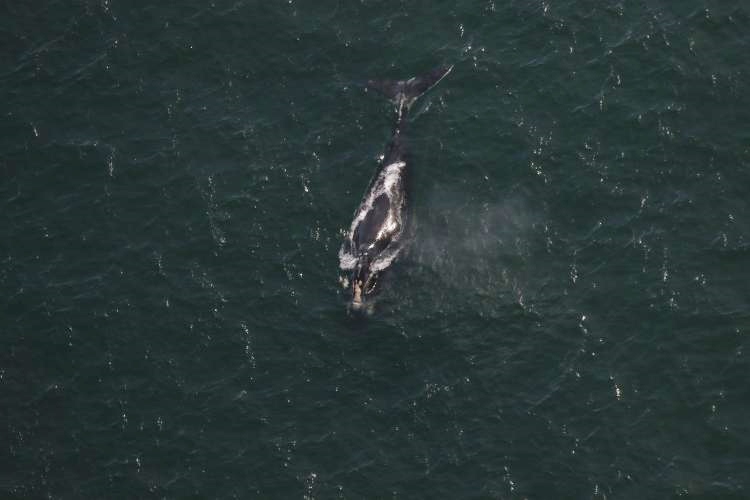An airborne search for a juvenile right whale last seen entangled in fishing gear off New Jersey instead turned up a second entangled whale south of Nantucket on Oct. 19, NOAA officials said.
A Center for Coastal Studies aerial survey team spotted the entangled animal among several other right whales. The group sent out a response team that arrived at the scene around 1:30 p.m., removed some gear from the whale, and added a satellite buoy for tracking. The animal had a line over its head, exiting both sides of his mouth, and trailing for about three to four body lengths past its tail, according to a NOAA statement.
Experts at the New England Aquarium identified the whale as #3920, an 11-year-old male dubbed "Cottontail" by cetacean trackers. The whale had last been sighted in the area south of Nantucket in March – an area where NOAA frequently declares “slow zones” when vessels over 65 feet are supposed to limit their speed to 10 knots to reduce the danger of striking whales near the surface.
With only about 400 individuals surviving, the North Atlantic right whale is one of the most endangered species on Earth, with 31 documented dead in the last 3 years and 11 with serious injuries. Ship strikes and gear entanglements are leading causes.
A federal court ruling has given NOAA until May 2021 to come up with a revised plan to better protect the whales, and the agency is considering gear restrictions and area closures as options.
The Maine Department of Marine Resources staff has been meeting with the state’s lobster zone councils to come up with “conservation equivalency” measures to better protect right whales – short of area closures under consideration by federal officials.
In a Sept. 3 memo to federal officials, the Maine agency outlined what it foresees as the negative effect of closures.
“Effectiveness of area closures as a tool for risk reduction is predicated on the assumption that gear from these areas will be brought back to shore. This works best for areas in enclosed areas close to shore, like the one in Cape Cod Bay,” DMR staffers wrote. “In a year-round, offshore fishery, though, the likely result of area closures will be that gear is simply moved to areas adjacent to the closure, creating a ‘curtain effect’ around the closed area. These curtains of gear may displace risk to right whales, rather than remove it,” they wrote.
The Maine officials anticipate a big hit on lobstermen that work waters beyond 12 miles – classified as offshore by their federal counterparts, but local waters to Maine island communities.
“Specifically, one closure crossed from LCMA 3 into LCMA 1, and impacted portions of Zones B, C and D outside of 12 miles from shore. This area, across these three zones produced over $14 million in ex-vessel value in 2019, representing 53% of the revenue generated outside of 12 miles from shore for the entire State of Maine.”
Among the counterproposals coming from Maine are “weak points,” sections of line designed to part with a breaking weight of 1,700 pounds if snagged by a cetacean.
The state agency has been working in collaboration with the industry to develop those weak points, including breaking over 1000 samples of different weak point configurations.
For use in state waters, Maine officials are suggesting a single 1,700-pound weak point halfway down all vertical lines. From 3 miles out to 12 miles offshore, they would prescribe two weak points in the top half of all vertical lines – the first one-quarter of the way down and another halfway down.
Beyond 12 miles that proposed measure would set one 1,700-pound weak point one-third of the way down all vertical lines.







